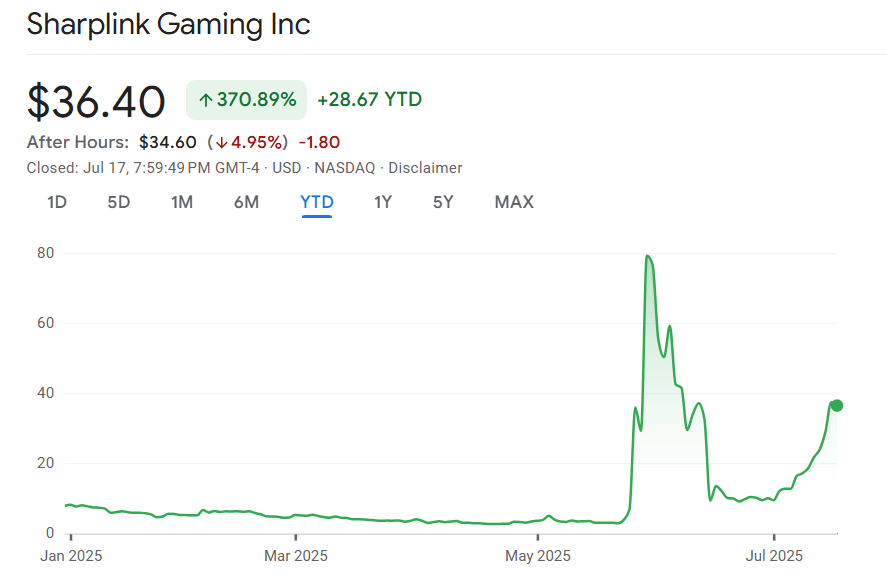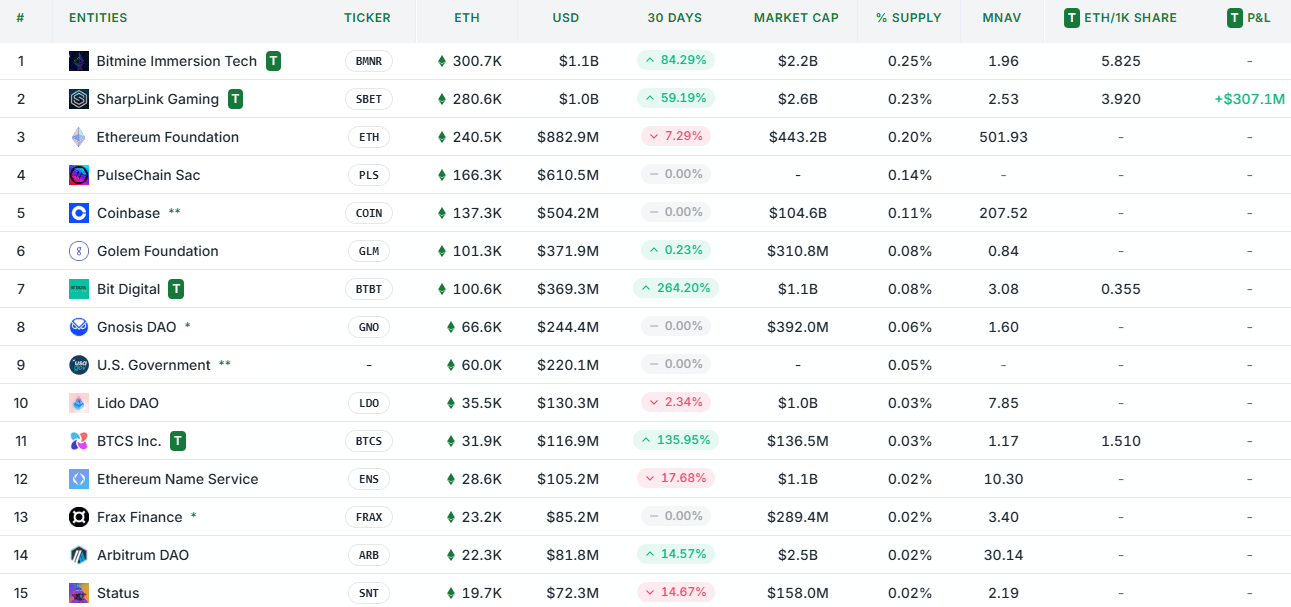Summary
SharpLink Gaming (SBET) and Bitmine Immersion Technologies (BMNR) are vying for the top seat of ETH treasury bonds exceeding $1 billion.
Other entities are exploring purchasing ETH or using their reserves to transform into treasuries.
ETH has broken $3,600, drawing attention to its long-term value and staking potential.
Ethereum (ETH) has risen to a five-month high, breaking $3,600, and is expected to reclaim higher price ranges. As Ethereum officially enters a bull market, corporate buyers are once again in the spotlight for their long-term holding of ETH.
Ethereum fund management companies first appeared during a slow accumulation period when ETH prices were still hovering below $2,800. The ETH fund management announcement also broke the model of BTC fund management companies, uncovering an asset with greater upside potential.
ETH treasury bonds may also open doors for accumulating other altcoins, restoring assets from old cycles and providing access to liquidity in traditional markets.
ETH treasury bonds have triggered a honeymoon period for corporate stocks.
Like the inflow of BTC government bonds, companies holding ETH have also seen a recovery and increase in their stock prices. Part of the growth is due to expectations of government bond appreciation. These stocks also provide indirect exposure to ETH, creating a flywheel effect that drives valuations to peak.
However, ETH fund management companies remain highly volatile. Bitmine Immersion Technologies, Inc. (BMNR) surged above $135 shortly after the fund management announcement was released, then fell to $41.90 and consolidated near a lower baseline.
SharpLink Gaming (SBET) has experienced another expansion, rebounding to $36.40 after a recent decline.

As ETH breaks into higher price ranges, SharpLink Gaming (SBET) has experienced a secondary recovery. | Source: Google Finance.
The success of the company's stock has prompted it to reassess its capital raising plans. SharpLink has revised its filing with the U.S. Securities and Exchange Commission (SEC) to announce a $6 billion common stock ATM plan, up from a previously planned $1 billion capital raise.
BitDigital (BTBT) is one of the best-performing stocks of 2025, recently rebounding to $4.01, setting a new annual high. In the recent BTC rebound, leading ETH companies seem to be revitalized again, continuously rising with expectations of a larger bull market. Which ETH treasury bonds have broken the $1 billion mark?
The recent appreciation of ETH has caused the total amount of the two major ETH reserves to exceed $1 billion. The stars of this cycle include BMNR and SBET, but some unexpected 'whales' are also showing their influence. As of July 2025, about 55 known entities hold over 100 ETH reserves, while about 5 well-known corporate buyers remain.

A total of 55 known entities' wallets hold over 100 ETH. BMNR and SBET are vying for the lead over Bitcoin Strategy (MSTR). | Source: Strategic Eth Reserves.
The total treasury amount of BMNR and SBET still accounts for less than 0.5% of the ETH supply. In contrast, after years of accumulation, Strategy (MSTR) holds over 3% of the BTC supply.
The recent expansion of ETH is just the beginning, as these companies have exhausted their initial round of financing in ETH. So far, corporations have purchased 1.7 million ETH but still need to catch up with the 5.1 million ETH held by ETFs.
Even in a slightly inflationary network, the total purchases by corporations and ETFs have exceeded 186 times the new ETH supply. Coupled with the demand for leveraged coverage of ETH, a new wave of corporate buyers may cause supply tightness, as mega-whales compete to purchase readily available ETH.
As ETH supply flows into mega-whale wallets and treasuries, the perception of the token may shift from a utility asset used for fees to a means of value storage.
Crypto-native projects may transform into financial companies.
ETH has a list of holders from previous bull market cycles. The current active purchasing volume of ETH has already surpassed some of the largest fundraising amounts, even exceeding the holdings of the Ethereum Foundation.
However, an increasing number of ETH holders may join the trend of 'Treasuries' by reshaping their reserve assets. Similar to BTC, whales and holders can finance through shell companies, linking idle ETH holdings to publicly traded stocks.
Projects like PulseChain have held over 166,000 ETH, placing them among the largest holders. Older ICO projects like Status hold 19,700 ETH. The remaining ETH is also stored in DAO treasuries, old ICO wallets, and other reserves.
Previously, some ETH holders would trade or use the tokens for operational expenses. The launch of the 'Treasury' feature has opened up new avenues for unlocking the value of ETH, while also enhancing its scarcity.
ETH staking may require additional regulation.
ETH tokens are not idle. The simplest solution is to stake the Beacon contract, which holds nearly 30% of the ETH supply. However, there are regulatory issues with this form of passive income due to its linkage to government bonds and publicly listed companies.
Although staking is generally considered safe, there are still technical risks involved when withdrawing staked assets, such as errors. Some fund management companies also adopt liquid staking, which increases the risk of 'seizure'. Additionally, reusing staked ETH for passive income may reduce the availability of actual ETH in fund management, raising concerns about ownership and access.
Currently, staking regulation may first target ETF buyers, after which corporate buyers will be allowed to explore staking channels. Even without regulation, SharpLink Gaming continues to use its ETH reserves for staking. Since announcing the launch of its 'Treasury' program, the company has added approximately 415 ETH in staking rewards.



